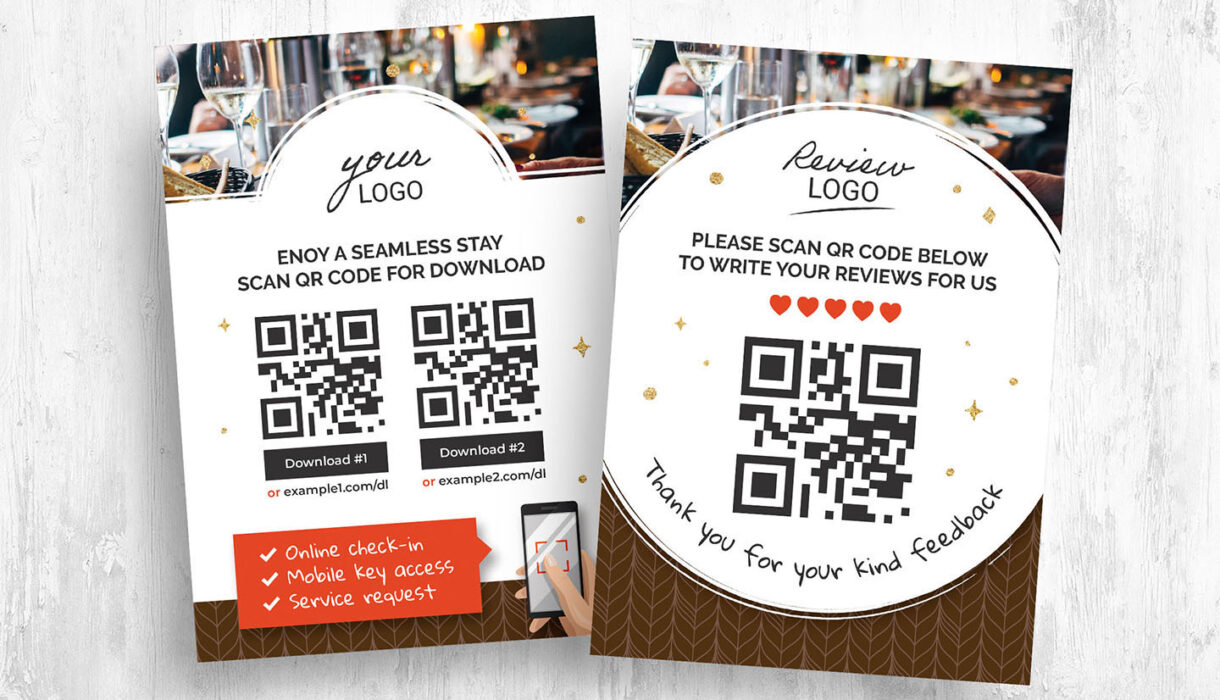
Sustainable QR Strategies: How Businesses Are Reducing Paper in 2025
Posted in :
Introduction: The Green Revolution Through QR Technology
As environmental consciousness reaches unprecedented levels in 2025, businesses are discovering that QR codes represent far more than digital convenience—they’re becoming a cornerstone of corporate sustainability initiatives. The transformation from paper-heavy operations to QR-enabled digital workflows has created measurable environmental impact while delivering substantial cost savings and operational efficiency improvements.
Recent sustainability reports indicate that businesses implementing comprehensive QR strategies have reduced paper consumption by an average of 73%, with some organizations achieving complete paper elimination in customer-facing operations. This shift represents not just environmental responsibility, but a fundamental reimagining of how businesses interact with customers, manage operations, and contribute to global sustainability goals.
The convergence of environmental necessity, consumer expectations, and technological capability has created the perfect storm for QR-driven sustainability initiatives. From restaurants eliminating single-use menus to healthcare facilities digitizing patient forms, organizations across every sector are discovering that QR codes offer the most practical path toward meaningful paper reduction.
This comprehensive analysis examines how forward-thinking businesses are leveraging QR technology to create sustainable operations, the measurable environmental and financial impacts of these initiatives, and the proven strategies that deliver both ecological and business benefits.
The Environmental Impact of Paper Consumption
Global Paper Waste Crisis
Staggering Consumption Statistics The global paper industry consumes approximately 4 billion trees annually, with commercial printing and office operations accounting for 26% of total paper usage. In 2024, businesses worldwide generated over 300 million tons of paper waste, with restaurants, healthcare facilities, and retail operations representing the largest contributors to single-use paper consumption.
Carbon Footprint Reality Paper production generates 3.3 tons of CO2 per ton of paper produced, making it one of the most carbon-intensive materials in common business use. The transportation, storage, and disposal of paper products add an additional 1.2 tons of CO2 per ton, creating a total environmental footprint that extends far beyond the initial production process.
Water and Chemical Impact Manufacturing one ton of paper requires 17 trees, 26,500 liters of water, and produces 58 pounds of chemical waste. The bleaching and processing chemicals used in paper production contribute to water pollution and ecosystem disruption, while deforestation for paper production destroys critical carbon-sequestering forests.
Business-Specific Paper Consumption Patterns
Restaurant Industry Impact The average restaurant prints 2,400 menus annually, with each menu costing $0.85 to produce and lasting only 3-6 months before replacement. Fine dining establishments often reprint menus weekly for seasonal changes, generating over 15,000 individual menu prints per year per location.
Healthcare Sector Consumption Healthcare facilities generate an average of 6.5 pounds of paper waste per patient per day, with administrative forms, patient information sheets, and educational materials comprising 67% of total paper usage. Large hospitals can consume over 2 million sheets of paper monthly for patient-facing communications alone.
Retail and Consumer Goods Retail operations produce an estimated 1.3 billion receipts daily in the United States alone, with each thermal paper receipt containing BPA chemicals that prevent recycling. Product information sheets, promotional materials, and instruction manuals add another 2.8 billion paper pieces annually to retail paper consumption.
Corporate Office Operations The average office worker uses 10,000 sheets of paper annually, with 45% of printed documents being discarded within 24 hours. Meeting materials, reports, and temporary reference documents comprise the majority of this waste stream, with 78% of these materials available in digital formats.
QR Code Solutions for Paper Reduction
Digital Menu Revolution
Restaurant Transformation Success Stories Leading restaurant chains have achieved remarkable paper reduction through QR menu implementation:
McDonald’s Global Initiative: The fast-food giant eliminated 2.3 billion paper napkins and promotional materials annually by integrating QR codes for nutritional information, promotions, and ordering. This initiative alone saved 15,400 trees yearly while reducing printing costs by $18 million globally.
Starbucks Digital Integration: The coffee chain’s QR-based loyalty program and digital menu system eliminated 890 million paper receipts annually, reducing paper consumption by 67% while increasing customer engagement by 34%. Digital menu boards with QR codes for detailed nutritional information replaced 125,000 printed menu cards across 8,000 locations.
Local Restaurant Impact: Independent restaurants implementing QR menus report average paper reductions of 85%, with seasonal menu changes now requiring zero printing. The Italian restaurant chain Olive Garden saved $2.4 million annually in printing costs while eliminating 5.6 million menu reprints through QR implementation.
Healthcare Digitization Breakthroughs
Patient Information Systems Healthcare facilities adopting QR-based patient information systems have achieved dramatic paper reductions:
Mayo Clinic Digital Transformation: The healthcare network eliminated 4.2 million patient information sheets annually through QR codes linking to personalized health portals. Patients now access treatment plans, medication information, and follow-up instructions through QR codes, reducing paper usage by 78% while improving information retention by 45%.
Kaiser Permanente Paperless Initiative: The integrated healthcare system replaced printed forms with QR-accessible digital intake processes, eliminating 12 million paper forms annually. Patient satisfaction increased 23% due to streamlined check-in processes, while paper costs decreased by $3.8 million yearly.
Dental Practice Efficiency: Dental practices implementing QR-based patient education report 92% reduction in printed educational materials. Patients receive post-procedure care instructions, appointment reminders, and oral health resources through QR codes, improving compliance by 56% while eliminating paper waste.
Retail and Consumer Goods Innovation
Product Information Digitization Retail organizations are revolutionizing product information delivery through QR integration:
IKEA Assembly Revolution: The furniture retailer eliminated 240 million printed assembly instruction booklets by implementing QR codes linking to interactive digital guides. This initiative reduced paper consumption by 15,000 tons annually while improving assembly success rates by 67% through video demonstrations and augmented reality features.
Unilever Packaging Innovation: The consumer goods company integrated QR codes on product packaging to deliver sustainability information, usage instructions, and recycling guidelines. This eliminated 45 million printed information inserts annually while increasing consumer engagement with sustainability messaging by 89%.
Best Buy Technical Documentation: The electronics retailer replaced printed user manuals with QR codes linking to comprehensive digital resources. This initiative eliminated 8.2 million printed manuals annually, saved $4.1 million in printing costs, and provided customers with always-updated technical information and video tutorials.
Measurable Environmental and Financial Benefits
Carbon Footprint Reduction Data
Quantified Environmental Impact Organizations implementing comprehensive QR strategies report significant environmental improvements:
Carbon Emissions Reduction: Businesses eliminating paper through QR codes reduce carbon emissions by an average of 4.7 tons CO2 annually per 1,000 customers served. Large-scale implementations show emissions reductions of up to 340 tons CO2 annually for major restaurant chains.
Forest Conservation Impact: QR-driven paper elimination saves approximately 12 trees per 10,000 QR code scans for previously printed materials. Organizations with high-volume paper usage report saving 200-500 trees annually through comprehensive QR implementation.
Water Conservation Benefits: Paper production requires 26,500 liters of water per ton produced. Businesses eliminating paper through QR codes conserve an average of 125,000 liters of water annually per location, with large-scale implementations saving millions of liters yearly.
Cost Savings Analysis
Direct Printing Cost Elimination Organizations report substantial immediate savings through QR implementation:
Restaurant Sector Savings: Restaurants implementing QR menus save an average of $8,400 annually on printing costs, with fine dining establishments saving up to $24,000 yearly through elimination of frequent menu reprints. Additional savings of $3,200 annually result from reduced storage space requirements for printed materials.
Healthcare Cost Reductions: Medical facilities report average annual savings of $15,600 per 1,000 patient visits through QR-based information delivery. Large hospitals save $180,000-$340,000 annually through comprehensive paper elimination programs, including forms, educational materials, and administrative documents.
Retail Operation Savings: Retail businesses implementing QR product information systems save an average of $12,300 annually on printing costs, with additional savings of $4,800 from reduced warehouse space needed for printed materials storage.
Operational Efficiency Improvements
Workflow Optimization Benefits QR implementation creates measurable operational improvements beyond cost savings:
Staff Time Reduction: Restaurants using QR menus report 35% reduction in time spent on menu maintenance, with staff previously dedicated to menu printing and replacement reassigned to customer service. Healthcare facilities save 45 minutes daily per staff member through elimination of paper form processing.
Inventory Management Efficiency: Organizations using QR codes eliminate inventory management for printed materials, reducing administrative overhead by 23%. Storage space previously used for printed materials can be repurposed for revenue-generating activities.
Update and Maintenance Speed: Digital content accessible through QR codes can be updated instantly, eliminating the 3-7 day lead time required for printed material updates. This agility allows for real-time promotional changes, menu updates, and information corrections.
Industry-Specific Implementation Strategies
Food Service and Hospitality
Comprehensive Digital Transformation Leading food service operations implement multi-layered QR strategies:
Menu and Ordering Integration: Successful restaurants combine QR menus with digital ordering systems, eliminating paper menus while streamlining operations. Table-side QR codes link to digital menus with real-time availability updates, reducing both paper waste and order errors by 67%.
Promotional Material Digitization: Restaurants replace printed promotional materials with QR codes linking to digital offers, event information, and loyalty programs. This approach eliminates 90% of promotional printing while enabling real-time campaign updates and personalized offers.
Receipt and Documentation Alternatives: Progressive restaurants offer QR-based digital receipts, nutritional information, and feedback collection, eliminating paper receipts while improving customer data collection and engagement.
Healthcare and Medical Services
Patient Experience Digitization Healthcare organizations implement comprehensive QR strategies for patient interaction:
Digital Forms and Intake: Medical facilities replace paper intake forms with QR codes linking to secure digital forms, reducing paper usage by 85% while improving data accuracy through automated validation. Patients complete forms before arrival, reducing wait times by 40%.
Educational Resource Delivery: Healthcare providers use QR codes to deliver patient education materials, medication instructions, and follow-up care information. This approach ensures patients receive current information while eliminating outdated printed materials.
Appointment and Communication Systems: Medical practices implement QR-based appointment confirmation, prescription pickup notifications, and test result delivery, eliminating paper-based communication while improving patient engagement and satisfaction.
Retail and Consumer Products
Product Information Revolution Retail organizations transform product information delivery through QR integration:
Interactive Product Guides: Retailers implement QR codes linking to comprehensive product information, including specifications, reviews, and usage videos. This eliminates printed product sheets while providing enhanced customer information and support.
Sustainability Communication: Forward-thinking brands use QR codes to communicate sustainability practices, recycling instructions, and environmental impact data, eliminating printed sustainability reports while increasing consumer engagement with environmental messaging.
Warranty and Support Services: Products include QR codes linking to digital warranty registration, support resources, and troubleshooting guides, eliminating printed documentation while providing always-updated support information.
Consumer Adoption and Environmental Awareness
Consumer Sustainability Preferences
Environmental Consciousness Trends Consumer behavior in 2025 demonstrates strong support for sustainable QR implementations:
Sustainability Preference Data: 78% of consumers actively prefer businesses offering QR-based alternatives to printed materials, with 67% reporting they’re more likely to support environmentally conscious organizations. Millennials and Gen Z consumers show 89% preference for digital QR interactions over paper-based alternatives.
Environmental Impact Awareness: 84% of consumers understand that QR codes reduce environmental impact, with 72% actively seeking businesses that demonstrate sustainability through digital alternatives. Consumer education campaigns about QR environmental benefits show 91% positive response rates.
Behavioral Change Adoption: Consumers who regularly interact with QR codes report 43% overall reduction in acceptance of printed materials, indicating that QR familiarity creates broader environmental consciousness and behavior change.
User Experience and Satisfaction
Digital Experience Quality Consumer satisfaction with QR-based sustainable alternatives shows positive trends:
Convenience Appreciation: 82% of consumers find QR-based information access more convenient than printed alternatives, citing ability to save information, share with others, and access from anywhere as primary benefits.
Information Quality Perception: Consumers rate QR-linked digital information as higher quality than printed materials, with 76% appreciating real-time updates, multimedia content, and interactive features unavailable in print format.
Environmental Pride Factor: 69% of consumers report feeling positive about their environmental contribution when using QR codes instead of printed materials, creating emotional engagement with sustainable business practices.
Technology Integration and Infrastructure
QR Code Generation and Management
Sustainable QR Platform Features Modern QR platforms support comprehensive sustainability initiatives:
Dynamic Content Management: Advanced QR platforms enable real-time content updates without code regeneration, maximizing the sustainability benefit by ensuring QR codes remain useful indefinitely. Dynamic codes eliminate the need for reprinting when information changes.
Analytics and Optimization: Comprehensive analytics track environmental impact metrics, including paper sheets saved, trees conserved, and carbon emissions reduced. This data enables organizations to measure and communicate sustainability achievements effectively.
Multi-Format Integration: Modern QR systems support various content types including videos, interactive forms, and augmented reality experiences, providing rich alternatives to printed materials while enhancing user engagement.
Security and Reliability
Trust and Safety Features Sustainable QR implementations prioritize security and reliability:
Brand Protection: Secure QR generation prevents malicious code creation while maintaining consumer trust in QR-based sustainability initiatives. Brand-integrated QR designs ensure authenticity and reduce security concerns.
Uptime and Accessibility: Reliable hosting infrastructure ensures QR-linked content remains accessible, preventing situations where users might revert to printed alternatives due to digital access failures.
Privacy Protection: Transparent data handling practices build consumer confidence in QR-based alternatives, supporting widespread adoption of sustainable digital alternatives.
Future Trends and Innovations
Emerging Sustainable QR Applications
Next-Generation Environmental Solutions Innovation in QR sustainability continues expanding:
Biodegradable QR Integration: Development of plant-based QR code printing materials enables temporary physical QR codes that decompose naturally while providing digital access to permanent information resources.
Augmented Reality Environmental Education: QR codes launching AR experiences that visualize environmental impact create powerful educational tools, showing consumers the real-time environmental benefits of their sustainable choices.
Blockchain Integration: QR codes linking to blockchain-verified sustainability data provide transparent environmental impact tracking, enabling consumers to verify the authentic environmental benefits of their sustainable choices.
Regulatory and Policy Developments
Government Sustainability Initiatives Policy trends supporting QR-based sustainability:
Digital-First Regulations: Government policies increasingly favor digital information delivery, with new regulations requiring paper alternatives for certain industries. Tax incentives for businesses demonstrating measurable paper reduction through digital alternatives.
Environmental Reporting Requirements: Corporate sustainability reporting now includes digital transformation metrics, with QR-based paper reduction contributing to environmental compliance scores and sustainability ratings.
Public Sector Leadership: Government agencies implementing QR-based public information systems, eliminating millions of printed forms and documents while demonstrating sustainable practices for private sector adoption.
Implementation Best Practices and Strategies
Planning Sustainable QR Initiatives
Comprehensive Assessment Framework Successful sustainable QR implementation requires systematic planning:
Baseline Paper Audit: Organizations should conduct comprehensive paper usage audits, identifying high-volume printing areas, seasonal variations, and waste streams suitable for QR replacement. This audit establishes baseline metrics for measuring environmental impact improvements.
Stakeholder Engagement Strategy: Successful implementations involve all stakeholders in sustainability planning, including customers, employees, and suppliers. Change management strategies ensure smooth transition from paper-based to QR-based systems.
Phased Implementation Planning: Organizations achieve best results through gradual QR rollout, starting with high-impact, low-resistance applications before expanding to comprehensive paper elimination. This approach builds user confidence and organizational expertise.
Measuring Environmental Impact
Comprehensive Metrics Framework Organizations track multiple environmental metrics to demonstrate sustainability impact:
Direct Paper Reduction: Track sheets of paper eliminated, converting to trees saved, water conserved, and carbon emissions prevented. Regular measurement enables organizations to quantify and communicate environmental achievements.
Secondary Environmental Benefits: Monitor indirect environmental benefits including reduced transportation for printed materials, decreased warehouse space requirements, and elimination of chemical waste from printing processes.
Consumer Engagement Metrics: Track consumer adoption rates, satisfaction scores, and environmental awareness improvements to demonstrate broader sustainability impact beyond direct paper reduction.
For organizations ready to implement sustainable QR strategies that deliver measurable environmental impact, QRCodeMyURL.com provides the foundation for professional, eco-friendly QR code solutions:
- Sustainability-Focused Generation: QR codes optimized for long-term use and maximum paper replacement potential
- Environmental Impact Tracking: Built-in analytics to measure paper reduction and environmental benefits
- Dynamic Content Management: Update information without regenerating codes, maximizing sustainability benefits
- Professional Quality Assurance: High-resolution codes suitable for all sustainable business applications
Start Your Sustainable QR Initiative →
Conclusion: The Sustainable Future of Business Operations
The evidence from 2025 demonstrates that QR codes represent far more than technological innovation—they’re essential tools for environmental responsibility. With businesses achieving 73% average paper reduction and organizations like McDonald’s eliminating billions of paper items annually, QR technology has proven its capacity to create meaningful environmental impact at scale.
The convergence of environmental benefits, cost savings, and operational efficiency creates a compelling business case that extends beyond sustainability compliance to competitive advantage. Organizations implementing comprehensive QR strategies report not only dramatic paper reduction but improved customer satisfaction, operational efficiency, and brand reputation.
Perhaps most significantly, consumer adoption and environmental awareness have reached levels that make sustainable QR implementation not just environmentally responsible, but commercially essential. With 78% of consumers preferring QR-based alternatives and 84% understanding their environmental benefits, businesses face both opportunity and expectation to embrace sustainable digital transformation.
As we look toward 2026 and beyond, the organizations implementing comprehensive QR sustainability strategies today will establish themselves as environmental leaders while building resilient, efficient operations that benefit both business performance and planetary health. The question is no longer whether to implement sustainable QR strategies, but how quickly organizations can transform their operations to meet both environmental imperatives and consumer expectations.
Essential Sustainability Resources
- Sustainable QR Implementation Toolkit – Complete guide for planning and executing paper reduction initiatives
- Environmental Impact Calculator – Tools for measuring and reporting sustainability achievements
- Consumer Education Templates – Resources for communicating environmental benefits to customers
- Regulatory Compliance Guide – Framework for meeting environmental reporting requirements
- Industry Benchmark Database – Paper reduction performance standards across sectors
Data Sources: Environmental impact data compiled from corporate sustainability reports, industry research studies, and environmental organizations tracking business sustainability initiatives throughout 2025.

